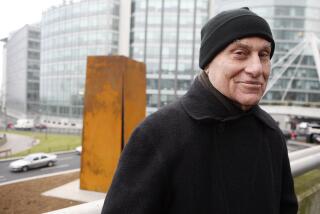The keystone to his art
GRAND RAPIDS, Mich. — His permanent works can inspire awe, but even Andy Goldsworthy’s temporary pieces have made a lasting impression on the art world.
The 49-year-old Scottish sculptor, land artist and photographer’s obsession with using twigs, leaves, sand, ice and other natural materials to craft artwork was the subject of a critically acclaimed 2001 documentary, “Rivers and Tides.”
The outdoors is Goldsworthy’s canvas. He’s always stopping in the woods to organize a colorful array of leaves on the ground or at the beach to fashion a sand sculpture near the water.
Another of his obsessions is the focus of “Andy Goldsworthy: Arches,” his largest U.S. exhibition to date. The show at Frederik Meijer Gardens & Sculpture Park runs through May 14.
It features 15 photographs that Goldsworthy has taken of some of his temporary art; five pedestal-scale sculptures; and two large works, including one that has been added to Meijer Gardens’ growing permanent collection.
“The permanent works are much more thought out and considered, and they’re not made with the same intuitive energy that the ephemeral works are,” he says. “And I like it because of that. They’re different in that way.”
“Grand Rapids Arch,” constructed outdoors from 37 huge stones obtained from a Scottish sandstone quarry, measures more than 18 feet tall and 35 feet long. Except for some pins used to anchor the two base rocks, nothing but gravity holds together the arch’s precisely cut stones.
For those who enjoy exploring art from every possible angle, there’s no reason to fear walking or standing beneath the massive arch, says Joseph Becherer, curator of sculpture at Meijer Gardens.
“The engineering is something that’s been tested for millennia and I think we’re very confident that what we’ve got there is strong and lasting,” he says.
The rest of the exhibit is indoors. One gallery houses the other major work, “Herd of Arches,” a series of 11 self-supporting stone arches, each around 4 feet tall, that give the impression they are in motion.
“They do have a kind of animal-like presence, a kind of animal-like quality to them,” Becherer says.
Goldsworthy, who spent about a week at Meijer Gardens in October installing “Grand Rapids Arch” but was not able to attend the opening of his show, says he has been building arches -- some permanent, others transitory -- for years.
Goldsworthy has plenty of ideas for more. He’s putting three arches on a hillside near his home in Scotland. A man in New Zealand wants him to install 11 arches along a shoreline and make them appear to be rising out of the sea. He’d like to put a “herd” of about a hundred in a field in Kansas.
“What intrigues me about the Midwest is this apparent flatness -- it contains this underlying movement,” he says. “That’s kind of the spirit of the Midwest, too. It may look flat, don’t let it kid you. There’s a lot of energy going on.”
Goldsworthy says it’s OK to sculpt one stone arch after another, “as long as I feel there’s more to be extracted from the idea.”
“But then something reaches its full capacity and there’s no reason to continue it,” he says. “Then I think repetition becomes a very dangerous thing for an artist because then it becomes a secure place to repeat a work for no reason.”
More to Read
The biggest entertainment stories
Get our big stories about Hollywood, film, television, music, arts, culture and more right in your inbox as soon as they publish.
You may occasionally receive promotional content from the Los Angeles Times.








